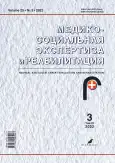Оценка заболеваемости раком тела матки в Чеченской Республике
- Авторы: Идрисова Л.С.1
-
Учреждения:
- Республиканский клинический центр охраны здоровья матери и ребенка имени Аймани Кадыровой
- Выпуск: Том 25, № 3 (2022)
- Страницы: 163-170
- Раздел: ОРИГИНАЛЬНОЕ ИССЛЕДОВАНИЕ
- URL: https://journal-vniispk.ru/1560-9537/article/view/131469
- DOI: https://doi.org/10.17816/MSER112153
- ID: 131469
Цитировать
Аннотация
Обоснование. Злокачественные новообразования репродуктивной системы являются важной медицинской и социально-экономической проблемой. В этом аспекте первостепенное значение приобретает углубленное изучение особенностей распространения отдельных нозологических форм гинекологической онкопатологии.
Цель. Оценка заболеваемости раком тела матки (РТМ) в Чеченской Республике (ЧР) и анализ состояния оказания онкологической помощи в сравнении с Северо-Кавказским федеральным округом (СКФО) и c Россией в целом.
Материал и методы. Единицы наблюдения: больные с РТМ. Период исследования 2014–2020 гг. Оценивались показатели заболеваемости, контингент больных, состоящих под диспансерным наблюдением, морфологическое подтверждение диагноза, дифференциация по стадиям заболевания, летальность, а также проведение лечения. Методы исследования: документальный, выкопировка данных, статистический и графический.
Результаты. Заболеваемость РТМ в России растет, прирост «грубого» показателя составил 28,79%, а стандартизованного 15,13% при среднегодовом темпе прироста 2,49 и 1,40% соответственно (различие статистически значимо). В ЧР доля больных, у которых РТМ выявлен на первой стадии злокачественного процесса меньше, а на второй стадии — выше показателей выявления в СКФО и в России в целом. Однако в ЧР доля больных с выявленным РТМ на III стадии в 2,3 раза превосходит экстенсивные показатели как по округу, так и по России. Летальность на первом году с момента установления диагноза в ЧР составила 6,5% (в России 7,6%, в СКФО 6,8%). В ЧР имеют место более низкие показатели удельного веса больных с РТМ, выявленных активно, а также больных, находящихся на диспансерном учете 5 лет и более, и больных, завершивших лечение в год выявления заболевания, по сравнению с показателями по СКФО и России.
Заключение. Представленные результаты оценки заболеваемости РТМ в ЧР в сравнительном аспекте с показателями заболеваемости в СКФО и в России целесообразно использовать при разработке приоритетных направлений первичной диагностики, проведения лечебных и реабилитационных мероприятий с учетом региональных особенностей. Крайне важен мониторинг факторов риска для реализации профилактических программ в рамках приоритетной сферы охраны здоровья населения.
Ключевые слова
Полный текст
Открыть статью на сайте журналаОб авторах
Лилия Султановна Идрисова
Республиканский клинический центр охраны здоровья матери и ребенка имени Аймани Кадыровой
Автор, ответственный за переписку.
Email: rkcozmir_ak@mail.ru
ORCID iD: 0000-0001-5931-0175
SPIN-код: 9996-4623
канд. мед. наук
Россия, ГрозныйСписок литературы
- Онкогинекология: национальное руководство / под ред. А.Д. Каприна, Л.А. Ашрафяна, И.С. Стилиди. М.: ГЭОТАР-Медиа, 2019. 384 с. doi: 10.33029/9704-5329-2-ONR-2019-1-384
- Гордиенко В.П., Леонтьева С.Н., Коробкова Т.Н. Рак репродуктивных органов у женщин Дальневосточного федерального округа // Сибирский онкологический журнал. 2020. Т. 19, № 3. С. 23–37. doi: 10.21294/1814-4861-2020-19-2-23-37
- Одинцова И.Н., Писарева Л.Ф., Пикалова Л.В., Кудяков Л.А. Эпидемиологические аспекты основных локализаций гинекологического рака в Томской области // Сибирский онкологический журнал. 2017. Т. 16, № 5. С. 48–54. doi: 10.21294/1814-4861-2017-16-5-48-54
- Kalampokas E., Giannis G., Kalampokas T., et al. Current approaches to the management of patients with endometrial cancer // Cancers (Basel). 2022. Vol. 14, N 18. P. 4500. doi: 10.3390/cancers14184500
- Siegel R.L., Miller K.D., Jemal A. Cancer statistics, 2019 // CA Cancer J. Clin. 2019. Vol. 69, N 1. P. 7–34. doi: 10.3322/caac.21551
- Kandoth C., Schultz N., Cherniack A.D., et al. Integrated genomic characterization of endometrial carcinoma. Project: Cancer Genome Atlas Research Network // Nature. 2013. Vol. 497, N 7447. P. 67–73. doi: 10.1038/nature12113
- Нечушкина В.М., Деньгина Н.В., Коломиец Л.А., и др. Практические рекомендации по лечению рака тела матки и сарком матки // Злокачественные опухоли: Практические рекомендации RUSSCO #3s2. 2018. Т. 8. С. 190–203. doi: 10.18027/2224-5057-2017-7-3s2-l68-l80
- Балтрукова А.Н., Берлев И.В., Берштейн Л.М. Сравнительная оценка гормонально-метаболического статуса больных раком эндометрия за последние пять десятилетий // Журнал акушерства и женских болезней. 2016. Т. 65, № 1. C. 9–16. doi: 10.17816/JOWD6519-16
- Resnick K.E., Hampel H., Fishel R., et al. Current and emerging trends in Lynch syndrome identification in women with endometrial cancer // Gynecol. Oncol. 2009. Vol. 114, N 1. P. 128–34. doi: 10.1016/j.ygyno.2009.03.003
- Бохман Я.В. Руководство по онкогинекологии. М.: Медицина, 1989. 325 с.
- Van den Bosch T., Coosemans A., Morina M., et al. Screening for uterine tumours. Best practice and research // Clinical obstetrics and gynaecology. 2012. Vol. 26, N 2. P. 257–266. doi: 10.1016/j.bpobgyn.2011.08.002
- Гавриш Ю.Е., Берлев И.В., Артемьева А.С. Рак тела матки у женщин старшего возраста: в чем особенности // Опухоли женской репродуктивной сферы. 2017. Т. 13, № 2. С. 56–60. doi: 10.17650/1994-4098-2017-13-2-56-60
- Panici P.B., Basile S., Giovanna М., et al. Secondary analyses from a randomized clinical trial: age as the key prognostic factor in endometrial carcinoma // Am. J. Obstet. Gynecol. 2013. Vol. 210, N 4. P. 363. doi: 10.1016/j.ajog.2013.12.025
- Злокачественные новообразования в России в 2020 году (заболеваемость и смертность) / под ред. А.Д. Каприна, В.В. Старинского, А.О. Шахзадовой. М.: МНИОИ им. П.А. Герцена, 2021. 252 с.
- Dinkelspiel H.E., Wright J.D., Lewin S.N., et al. Contemporary clinical management of endometrial cancer // Obstet. Gynecol. Int. 2013. Vol. 2013. P. 583891. doi: 10.1155/2013/583891
- Cusimano M.C., Simpson A.N., Dossa F., et al. Laparo-scopic and robotic hysterectomy in endometrial cancer patients with obesity: a systematic review and meta-analysis of conversions and complications // Am. J. Obstet. Gynecol. 2019. Vol. 221, N 5. P. 410–428. doi: 10.1016/j.ajog.2019.05.004
- Nevadunsky N.S., Van Arsdale A., Strickler H.D., et al. Obesity and age at diagnosis of endometrialcancer // Obstet. Gynecol. 2014. Vol. 124, N 2 (Pt. 1) P. 300–306. doi: 10.1097/AOG.0000000000000381
- Шакирова Е.А., Зотова О.А. Состояние метаболических процессов у женщин репродуктивного возраста с ожирением и гиперпластическими процессами эндометрия // Фундаментальная и клиническая медицина. 2016. Т. 1, № 2. С. 76–81.
- Alberti K.G., Eckel R.H., Grundy S.M., et al. Diabetes Federation Task Force on epidemiology and prevention // Circulation. 2009. Vol. 120, N 16. P. 1640–1645. doi: 10.1161/ CIRCULATIONAHA.109.192644
- Кишкина А.Ю., Коломиец Л.А., Юнусова Н.В. Клинические варианты метаболического синдрома у больных раком эндометрия // Сибирский онкологический журнал. 2019. Т. 18, № 5. C. 38–44. doi: 10.21294/1814-4861-2019-18-5-38-44
Дополнительные файлы








